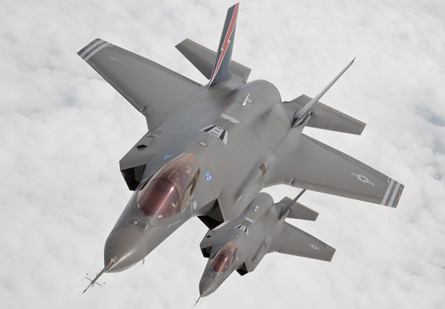With the development phase of the Lockheed Martin F-35 under close scrutiny by US Department of Defense officials, a long-awaited contract award shows that production costs are falling, while the risks are shifting from the government to the contractor.
A $3.5 billion contract awarded on 19 November completes the orders of 30 F-35s from the USA and one from the UK in the fourth annual lot of low-rate initial production, or LRIP-4. Two other deals awarded earlier for LRIP-4 aircraft raise their total cost to $4.6 billion, or about $148 million each.
That price includes charges, such as special tooling and test equipment that would not apply to new F-35 customers, but the number represents the true cost paid by the US and UK governments this year.
Lockheed also has not changed its long-term price forecast, which predicts the conventional take-off and landing F-35A will cost about $60 million per aircraft.
 |
|---|
© Lockheed Martin |
But such prices assume that production costs will steadily decline as deliveries of the F-35 ramp up to one per working day after 2016.
In 2008, DoD officials grew concerned about rising cost estimates in previous LRIP lots, and demanded a major change in LRIP-4.
Lockheed was ordered to convert LRIP-4 into a fixed-price deal two years ahead of schedule, forcing it to absorb a greater share of any cost overruns incurred until the 31 aircraft are delivered in fiscal year 2013.
DoD officials seem to be driving a hard bargain. Comparing LRIP-4 to the latest publicised estimates for LRIP-3, Lockheed must dramatically slash costs.
Lockheed's published contracts on LRIP-3 add up to $2.62 billion, or about $154 million for each of its 17 aircraft. However, a DoD report dated 31 December 2009 estimates that cost overruns on the cost-plus LRIP-3 contract will increase its value to $3.53 billion, or $207 million per aircraft.
This means Lockheed must effectively slash the ultimate costs for LRIP-4 by up to 25% to avoid new cost overruns on its fixed-price contract.
Meanwhile, DoD officials have been briefed on the results of a technical baseline review, which has reportedly forecast a new, $5 billion cost overrun and one-year delay for the development programme. The review has been folded into the Pentagon's fiscal year 2012 budget process, meaning its results are unlikely to be released until early February.
Lockheed's flight-test programme, meanwhile, is on track to complete 400 flights by the end of the year, which would slightly exceed a pledge to fly at least 394 sorties.
Source: Flight International
















